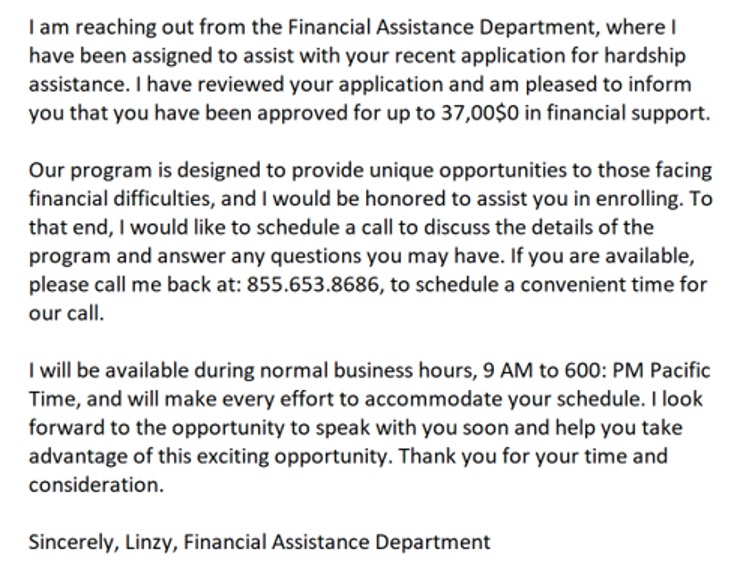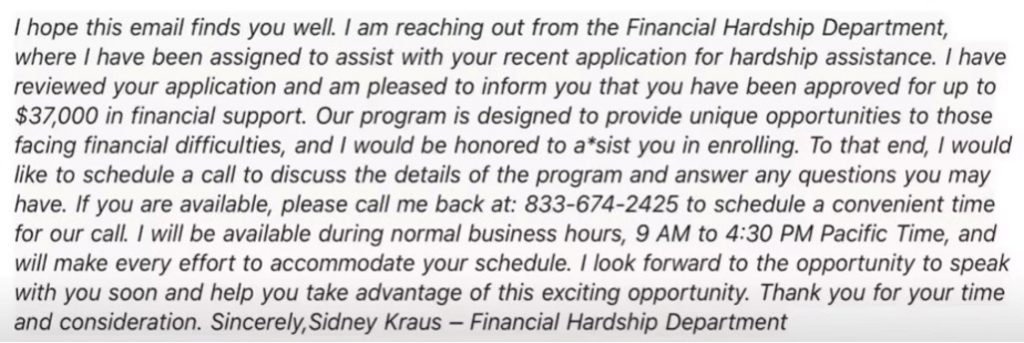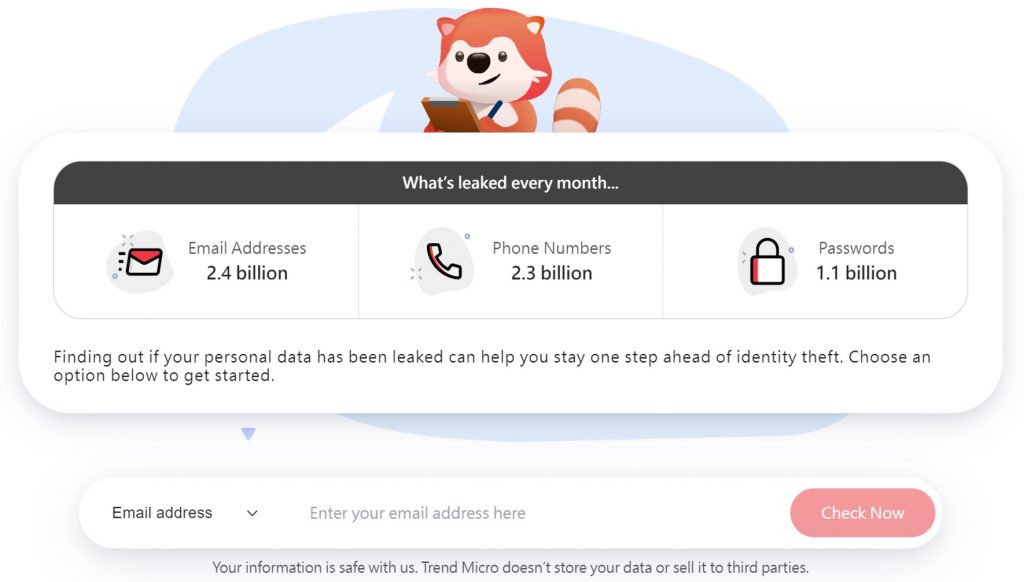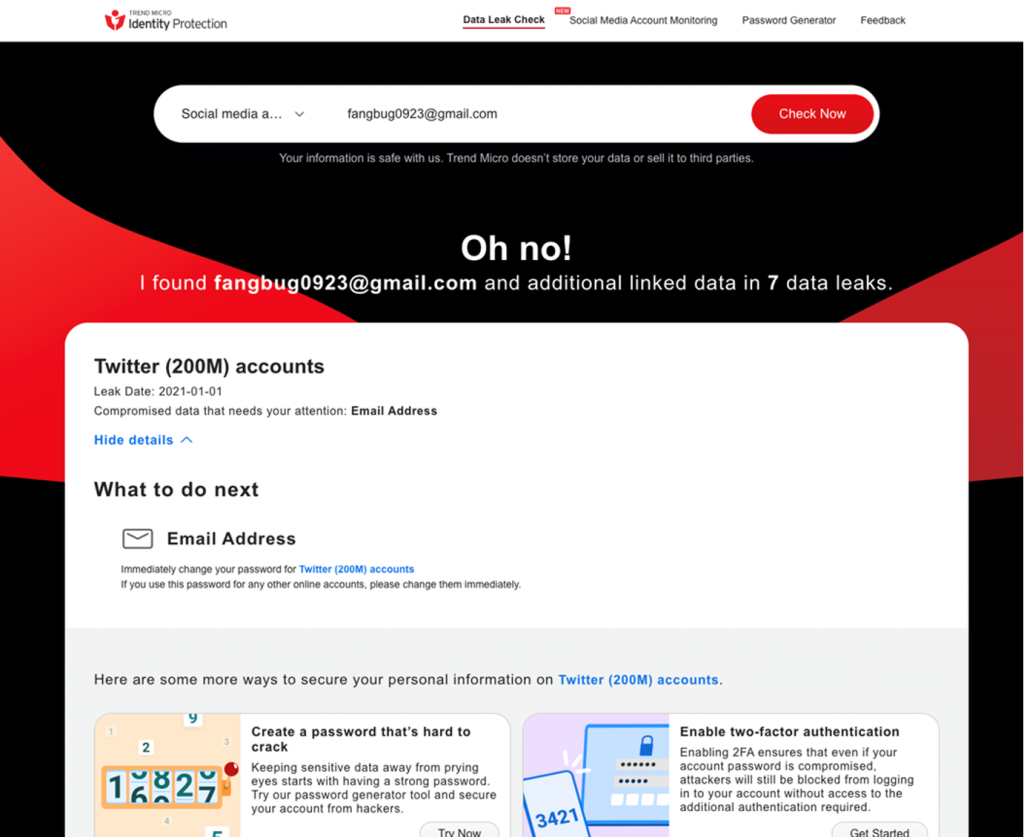Recently, we have been tracking a new and widespread type of financial aid scam, which preys on people’s economic hardship — something that has been a reality for many US citizens both during and after the COVID-19 pandemic. The financial assistance department scam is targeting unsuspecting individuals via email. The scam involves an email impersonating a representative from the “Financial Assistance Department”, which isn’t a real thing, and claims to offer financial aid and/or grants.
How the Financial Assistance Department Scam Works
The scam starts with a fake “financial assistance department email” sent to unsuspecting individuals at random. The email claims to be from said department and offers financial assistance. Unlike many other scams, the communication doesn’t use any logos or copied formatting, but is instead presenting as a generically official-looking email. It will use formal language and includes fake reference numbers, phone numbers, and other convincing (but fake) details.

The fake financial assistance department email instructs the would-be victim to call a phone number in order to complete the application process. However, the phone number provided is a direct line to the scammers. Phone numbers known to be used include:
- 855.931.6463,
- 833-674-2425,
- 855-783-7658,
- 855.653.8686,
- 855-919-6396,
- 855-816-4103,
- 855-455-5177,
- 855-544-6425,
- and 855-536-2749.
For more suspicious numbers, see the following useful comment section.

When the victim calls the number, they are asked to provide personal and financial credentials, such as Social Security number (SSN), bank account details, and credit card information. Once the criminals have this crucial info, they can commit monetary fraud and identity theft.
Other scam email templates include the following:
- Hi it’s Shela with the Financial Assistance Department. We tried reaching you at your home and did not hear back … I’m not sure if you’ve spoken to an assigned agent yet, but I do see that you’re pre-approved for our Hardship Program, so what I’m going to do is keep this in a pending status. And If you have about five minutes today give me a call so we can go over the details. My phone number is: 855-455-5177, Thank You, Shela Montalbano
- I am reaching out from the Financial Assistance Department, where I have been assigned to assist with your recent application for hardship assistance. I have reviewed your application and am pleased to inform you that you have been pre-approved for up to $37,000 in financial support. Our program is designed to provide unique opportunities to those facing financial difficulties, and I would be honored to assist you in enrolling. To that end, I would like to schedule a call to discuss the details of the program and answer any questions you may have.If you are available, please call me back at: 855.931.6463, to schedule a convenient time for our call. I will be available during normal business hours, 9 AM to 6:00 PM Pacific Time, and will make every effort to accommodate your schedule. I look forward to the opportunity to speak with you soon and help you take advantage of this exciting opportunity. Thank you for your time and consideration. Sincerely, Sigismond - Financial Assistance Department
- Dear ~, I hope this email finds you well. I am reaching out from the Financial Assistance Department, where I have been assigned to assist with your recent application for hardship a*sistance. I have reviewed your application and am pleased to inform you that you have been approved for up to $37,000 in financial support.Our program is designed to provide unique opportunities to those facing financial difficulties, and I would be honored to assist you in enrolling. To that end, I would like to schedule a call to discuss the details of the program and answer any questions you may have.If you are available, please call me back at: 833.674.2425 to schedule a convenient time for our call. I will be available during normal business hours, 9 AM to 4:30 PM Pacific Time, and will make every effort to accommodate your schedule. I look forward to the opportunity to speak with you soon and help you take advantage of this exciting opportunity. Thank you for your time and consideration. Sincerely, Goddart Depree – Financial Assistance Department
How to Protect Against the Financial Assistance Department Scam
The state government of Oregon has helpfully provided the following guidelines regarding what to do:
- “Do not reply to the email or call the phone number provided in the message.
- Do not click on any links or download any attachments provided in the email. They may contain malware or viruses that can harm your device.
- Do not provide any personal information, such as your Social Security number, bank account information, or credit card information.”
You should also report the scam to the relevant authorities, for example, the Federal Trade Commission (FTC). As far as the emails go, there are several flags, including:
- The email is unsolicited.
- The email is sent from an email address that does not match the name of a government office.
- The email uses time pressure to persuade the victim.
- The language used contains grammatical errors.
- The email promises a huge, and specific, amount of money.
- It does not provide any information about the program or the organization.
- The email provides very little information in general. At the same time, the names are not exactly common for the average US citizen.
- The email contains an unrelated message at the bottom, which suggests it is spam.
So, to summarize, if you or anyone you know receives one of these emails, the best advice is to IGNORE and REPORT.
Protecting Your Identity and Personal Info
Data leaks can have serious consequences, including identity theft, financial fraud, job losses, and company reputations lost overnight. The best thing you can do is a) have reliable cybersecurity protection, and b) ensure you will find out ASAP in the event of being affected. We would encourage readers to head over to our new FREE ID Protection platform, which has been designed to meet these challenges.

With ID Protection, you can:
- Check to see if your data (email, number, password, social media) has been exposed in a leak,
- Secure your social media accounts with our Social Media Account Monitoring tool, with which you’ll receive a personal report,
- Receive the strongest tough-to-hack password suggestions from our advanced AI.

All this for free — give it a go today. As always, we hope this article has been an interesting and/or useful read. If so, please do SHARE it with family and friends to help keep the online community secure and informed — and consider leaving a like or comment below. Here’s to a secure 2023!
